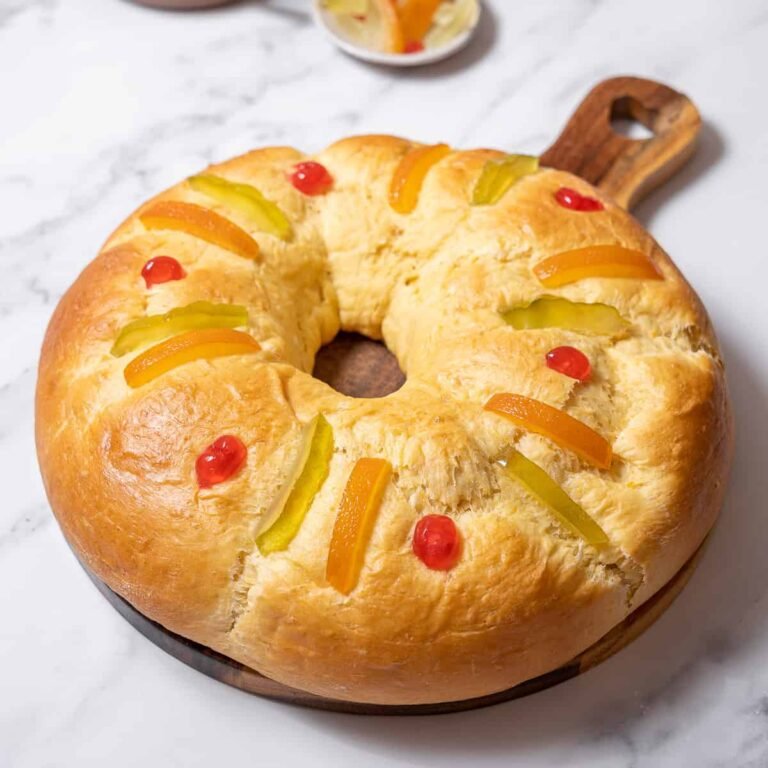
[ad_1]
Get ready for Epiphany or Día de Los Reyes Magos with a traditional roscón de reyes recipe! This popular Spanish kings’ cake appears in pastry shop windows starting in mid-November, and is the perfect snack alongside a thick cup of Spanish hot chocolate!
If you love Spanish food, be sure to try the most famous Spanish cakes and these Spanish Christmas recipes.
Jump to:
Introduction
These crown-shaped roscón de reyes (Spanish king cakes) fill the windows of pastry shops every winter, and small children rub their hands with glee just waiting to bite into one. If they’re lucky, they’ll even break a tooth on a ceramic figurine of baby Jesus hidden inside the cake!
The Three Kings’ Day (el día de los Reyes Magos) celebrates Epiphany on January 6th, and is the real Christmas Day for most Spaniards. Families gather for a huge feast, unwrap presents brought by the three kings, and watch a parade of elaborately decorated floats. The best part of the feast is the roscón de reyes, or kings’ cake, especially when it’s served with Spanish hot chocolate.
Ingredients
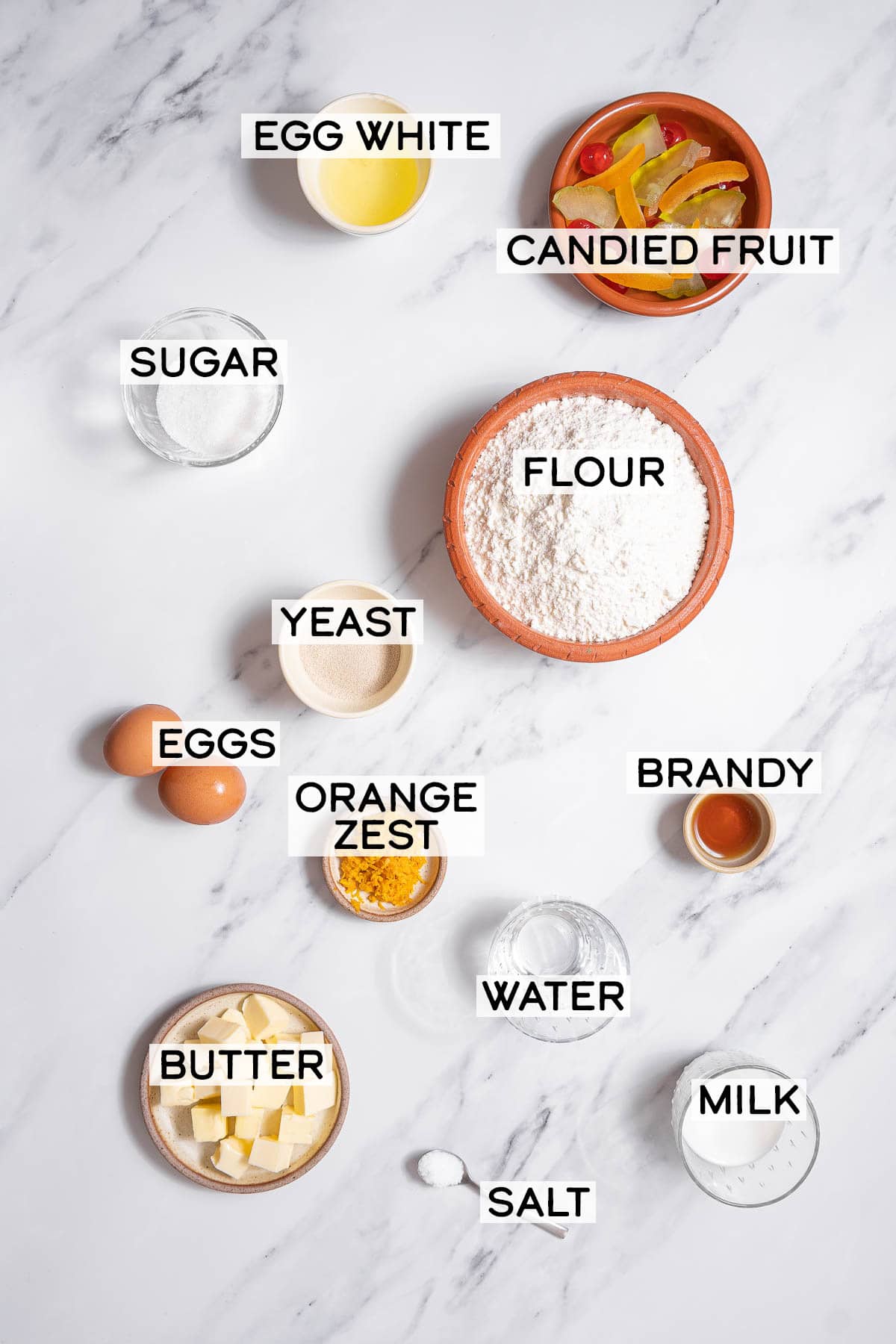
Wondering what you need to make your own amazing roscón de reyes? Fortunately, you don’t need anything fancy to make this centerpiece for your Día de Los Reyes celebration!
- Flour: All-purpose flour works in this recipe, but for a higher rise and chewier texture, try using bread flour.
- Yeast: Either active dry or instant yeast works well in this recipe.
- Candied Fruit: This is an important ingredient, as this decoration makes the bread look like a royal crown. Use whatever dried or candied fruits or nuts you’d like!
See recipe card for full information on ingredients and quantities.
How to Make Roscón de Reyes
If you’d like to see the full ingredients and instructions, scroll to the bottom of the post for the printable recipe card.
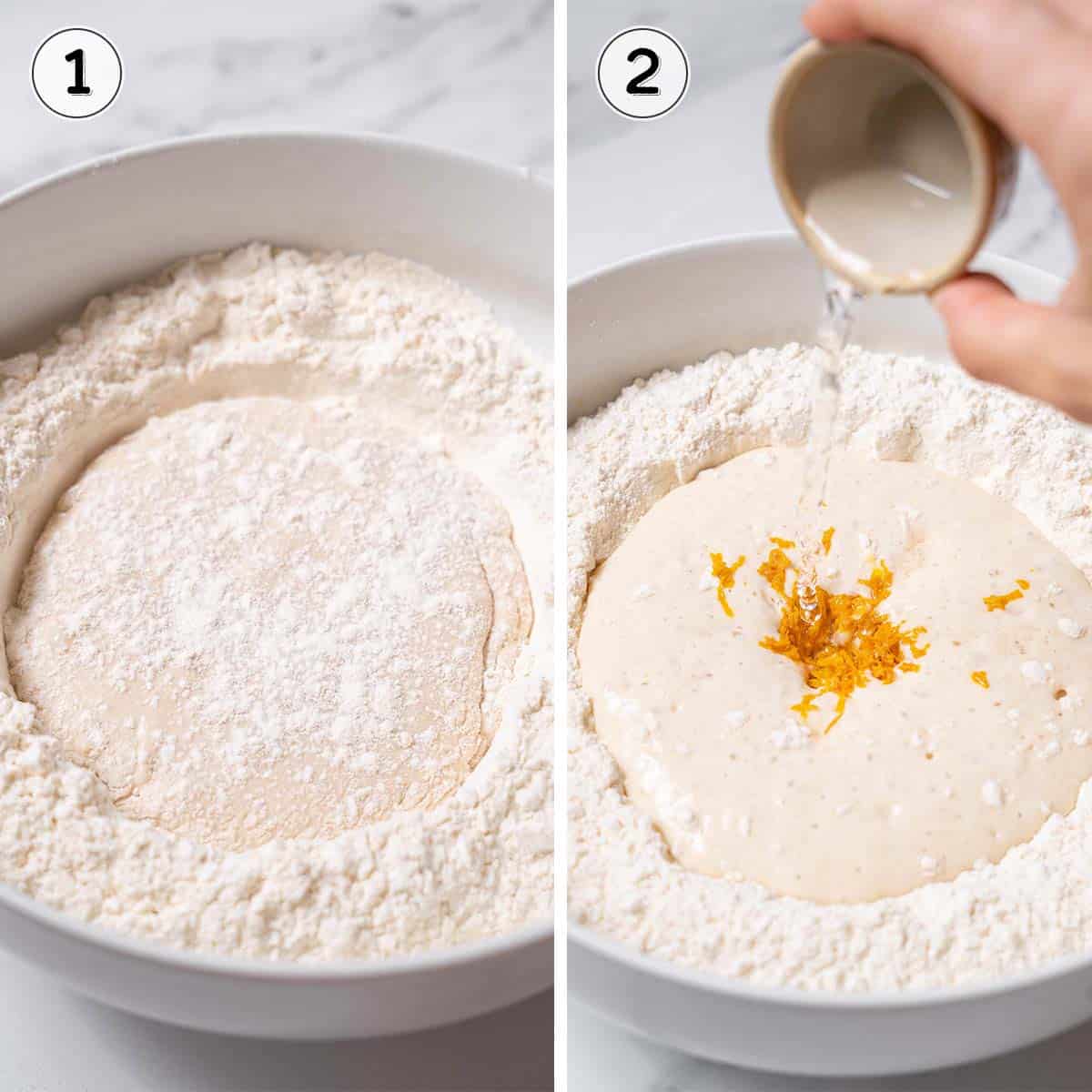
- Sift the flour and salt, then make a well in the middle. Dissolve the yeast in warm water and pour it into the center. Mix a little of the flour into the liquid to make a thick batter, then cover and let it stand for 15 minutes. (image 1)
- Once the dough is risen and spongy, add the orange rind, brandy, eggs, and a splash of water. (image 2)
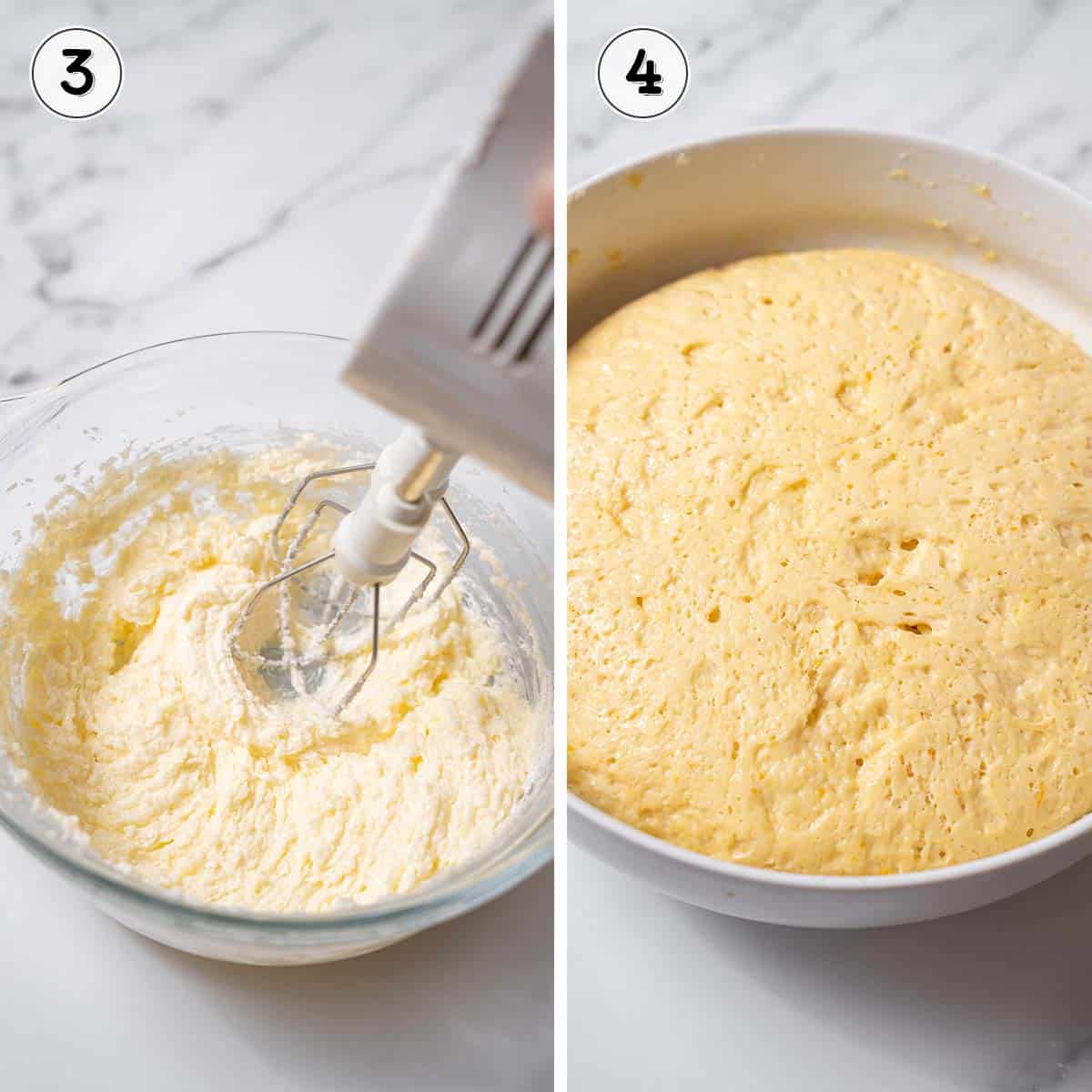
- Beat the butter and sugar together until it’s light and fluffy. (image 3)
- Knead the butter mixture into the dough, then let it rise until it’s doubled in size, about 1-2 hours. (image 4)
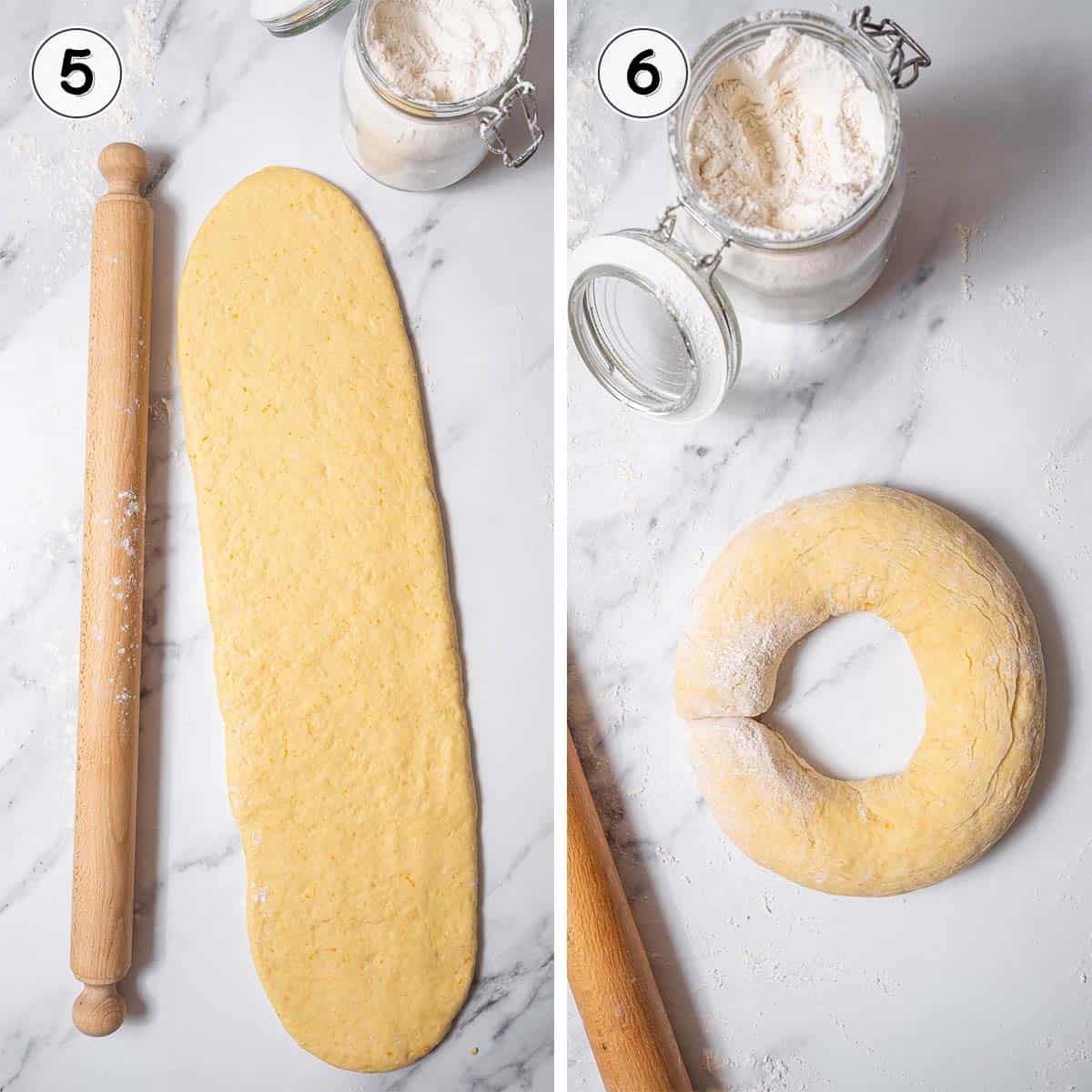
- Punch down the dough, then knead it for a couple of minutes. Roll the dough out into a large rectangle, about 2 feet long and 6 inches wide. (image 5)
- Roll the dough up from one of the long sides to create a long log, then shape it into a wreath or donut shape. Pinch the seam firmly together to seal. Add a bean or baby figurine now if you’d like. (image 6)
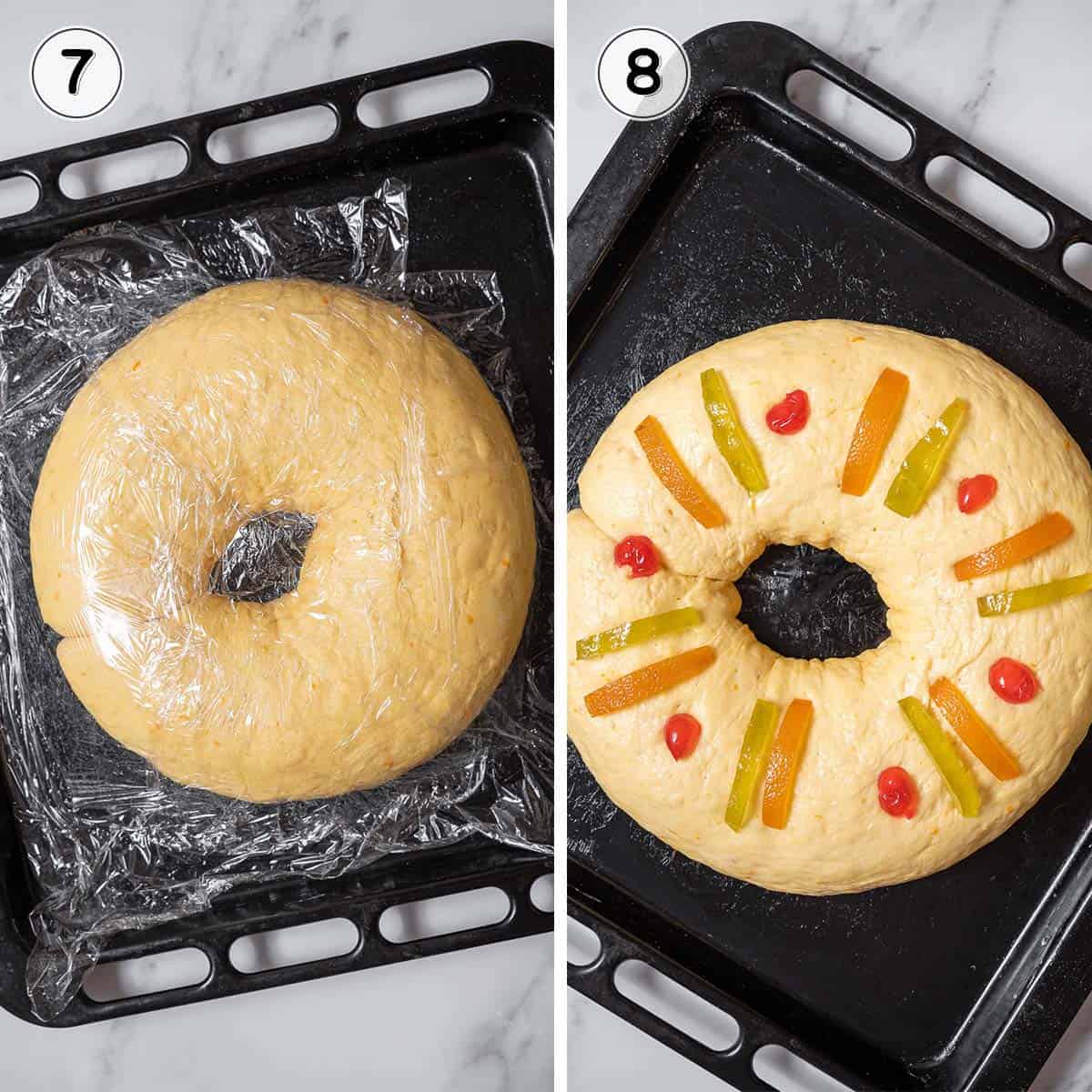
- Cover with plastic wrap and let the roscón rise until it’s nearly doubled in size, about 1 hour. (image 7)
- Beat an egg white and brush the roscón with it. Decorate the bread with candied fruits and peel as desired, pushing them gently into the dough so they don’t fall off while baking. (image 8)
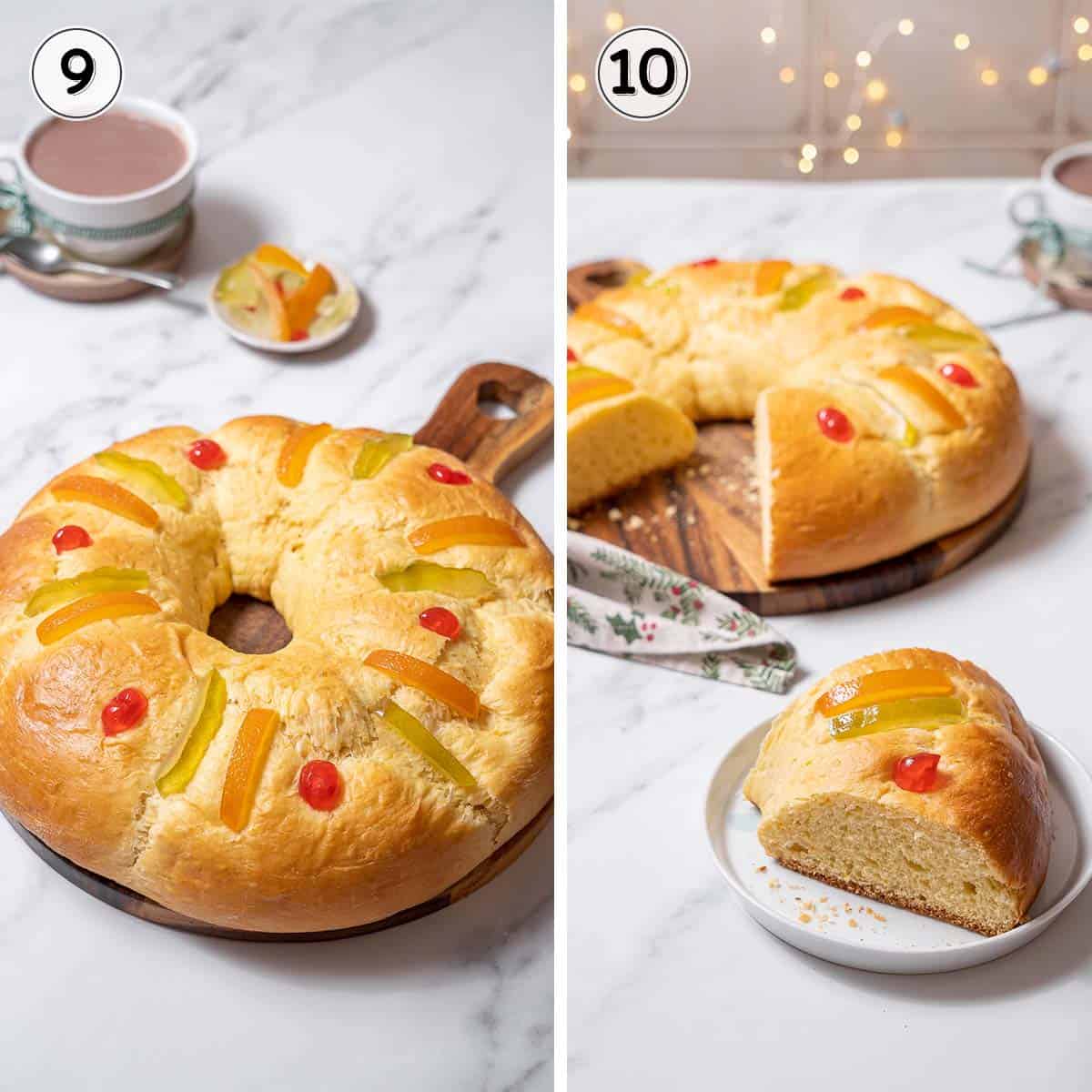
- Bake the roscón at 350°F (180°C) until the bread is golden brown, about 30 minutes. (image 9)
- Let the roscón cool on a wire rack completely before serving, then slice and serve with a cup of hot chocolate. (image 10)
Recipe FAQs
This once-a-year dessert is made of an oval-shaped sweet yeasted bread, similar to brioche. It can be served plain, but most often you’ll see it sliced in half and sandwiching a layer of sweet whipped cream–perhaps even with chocolate whipped cream!
The bread itself is topped with candied fruits, dried dates, and anything else sweet and colorful. The bread is said to represent the crowns worn by the kings who visited the baby Jesus and gave Him precious gifts.
Roscón de reyes is a round, donut-shaped sweet yeast bread served on Epiphany, or Día de Los Reyes (January 6). The dough is flavored with orange blossom water or orange zest, the top is decorated with candied fruit, and is often filled with whipped cream.
This tradition dates back to the Roman winter solstice celebration of Saturnalia, during which a similar cake would be served. Whoever found the hidden treat inside would be dubbed the king of the festival and treated like royalty. Over time, the cake’s popularity spread, and now it’s a popular Christmas tradition for families in Spain, France, and Latin America.
In Spain, roscón de reyes is traditionally served either on the night of January 5 or the morning of January 6 (Epiphany).
A small baby Jesus figurine is hidden in the dough, and whoever finds it in their slice is king for the day! According to tradition, finding the bean gives you wealth or good luck in the new year.
If you bite down on the fava bean, you’re the one who will bring the roscón to next year’s party!
Roscón de reyes means “ring of kings” in English. It could also be translated as “kings’ cake.”
Serve
Enjoy your roscón de reyes with a cup of Spanish hot chocolate for breakfast on January 6 (Día de los Reyes).
If you’re looking for more Spanish Christmas desserts, make sure to try these recipes for polvorones and mantecados.
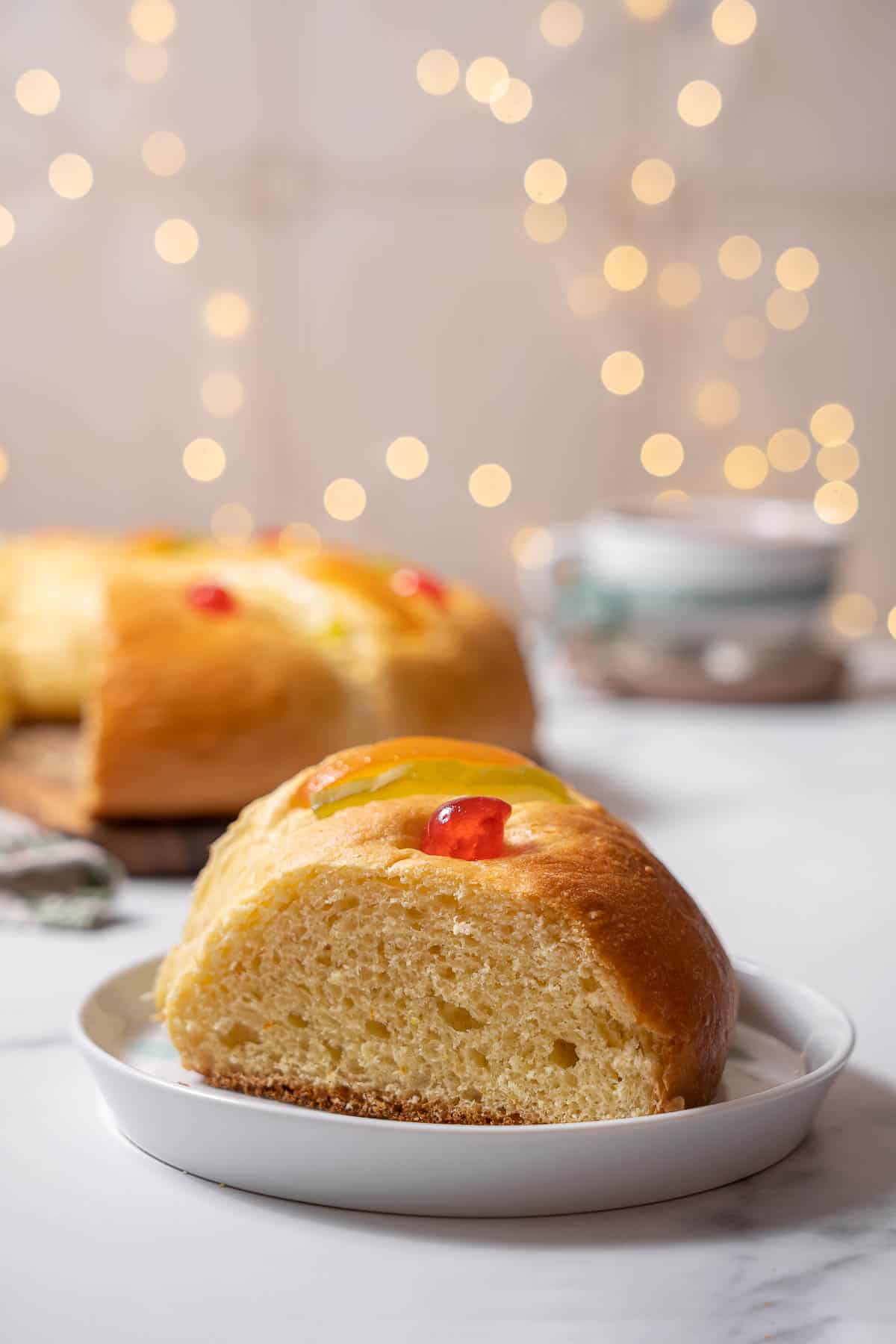
Expert Tips
- For a higher rise and chewier texture, try using bread flour instead of plain, all-purpose flour.
- Knead the dough until it passes the windowpane test to make sure it will rise well and have a good texture.
- Warm the liquids in the dough to around 115°F (46°C) for best results. Having the liquid too hot will kill the yeast.
- Create a warm, humid, and draft-free spot to let the dough rise by placing the dough in a cold oven with a pan of boiling water on a shelf beneath the dough.
- Want to add the traditional whipped cream filling? Let the roscón cool completely (about 1 hour), then slice it in half horizontally and pipe the cream inside.
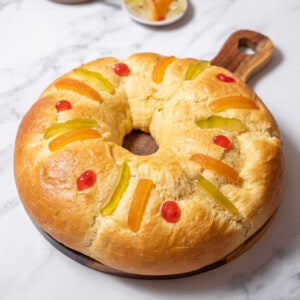
Roscón de Reyes Recipe (Spanish Kings’ Cake)
This classic cake is a traditional Christmas dessert in Spain and Latin America. It’s easy to make, and a fun game to play; find the hidden toy in your slice for good luck all year!
Print (images optional)
Pin
Rate
Servings: 10 slices
Calories: 435.92kcal
Instructions
Making the Dough
-
Sift the flour and salt into a large mixing bowl, then make a well in the middle.
-
Warm the milk and water to around 115°F (46°C), then stir the yeast into the liquids until it’s dissolved. Pour it into the well in the dry ingredients and mix a little of the flour into the liquid to create a thick batter. Sprinkle a little flour on top, cover, and let it rest until the batter is spongy, about 15 minutes.
-
While the dough is resting, cream the butter and sugar together until it’s smooth and creamy.
-
Once the dough is spongy, add the eggs, brandy, orange rind, and a splash of water to it. Mix until the dough is elastic and a little sticky, then mix in the creamed butter and sugar until the dough is smooth.
-
Shape the dough into a ball, place in a large bowl, and cover with oiled plastic wrap. Set it in a warm, draft-free place to rise until it’s doubled in size, about 1-2 hours.
-
While the dough rises, grease a large baking sheet for later use.
Shaping the Roscón
-
Once the dough has doubled, punch it down and place it on a lightly floured work surface. Knead the dough for 2-3 minutes, then roll it out into a large rectangle measuring roughly 2 feet long by 6 inches wide (60×15 cm).
-
Roll up the dough from one of the long sides to create a log shape, pinching the seam to seal. Squeeze the ends together tightly to create a wreath or donut shape, then place it on a greased baking sheet. Hide a bean or ceramic baby Jesus figurine inside the roscón now if desired.
-
Cover the bread with plastic wrap and let it rise in a warm place until nearly doubled in size, about 1 hour.
-
Preheat the oven to 350°F (180°C).
Decorating & Baking
-
Once the dough has risen, lightly beat the egg white and brush the bread with it. Decorate the roscón with the candied or dried fruits, pushing them gently into the bread so they do not fall off while it is baking.
-
Bake the bread until it’s golden brown and has a minimum internal temperature of 190°F (88°C). Let it cool completely on a wire rack, about 1 hour.
-
Slice the roscón and serve with Spanish hot chocolate. Leftovers can be frozen for up to 1 month.
Notes
- For a higher rise and chewier texture, try using bread flour instead of plain, all-purpose flour.
- Knead the dough until it passes the windowpane test to make sure it will rise well and have a good texture.
- Warm the liquids in the dough to around 115°F (46°C) for best results. Having the liquid too hot will kill the yeast.
- Create a warm, humid, and draft-free spot to let the dough rise by placing the dough in a cold oven with a pan of boiling water on a shelf beneath the dough.
- Want to add the traditional whipped cream filling? Let the roscón cool completely (about 1 hour), then slice it in half horizontally and pipe the cream inside.
Nutrition
Serving: 1slice | Calories: 435.92kcal | Carbohydrates: 81.18g | Protein: 7.4g | Fat: 8.49g | Saturated Fat: 4.83g | Polyunsaturated Fat: 0.64g | Monounsaturated Fat: 2.22g | Trans Fat: 0.28g | Cholesterol: 51.77mg | Sodium: 220.19mg | Potassium: 93.64mg | Fiber: 3.66g | Sugar: 29.9g | Vitamin A: 309.09IU | Vitamin C: 1.95mg | Calcium: 89.17mg | Iron: 3.6mg
Photography by Giulia Verdinelli
[ad_2]
Source link